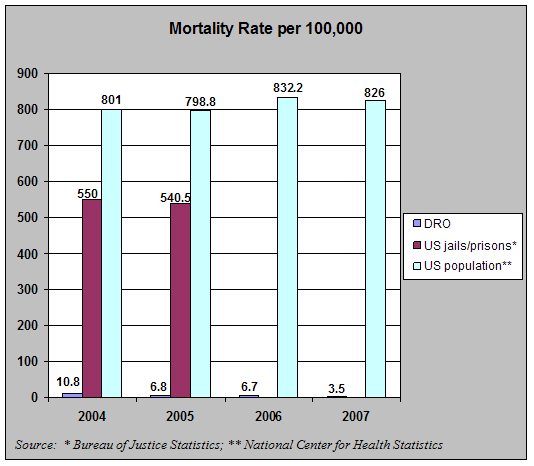
Quick Links
News
July 17, 2008
Mortality Rates at ICE Detention Facilities
U.S. Immigration and Customs Enforcement, Office of Detention and Removal (DRO) takes great care to ensure the safety and well being for each of the hundreds of thousands of individuals who come through our detention facilities each year. ICE has put processes in place with the U.S. Public Health Service, Division of Immigration Health Services (DIHS) medical professionals to provide care for all those detained, including those who may encounter a medical emergency while in custody. Though the ICE detainee population has increased by more than 30% since 2004, the mortality rate has actually declined. The number of deaths per 100,000 is dramatically lower for ICE detainees than for U.S. prisons and jails and the general U.S. population as a whole.
Detainee deaths over the past five years
| Calendar Year | Death Frequency |
|---|---|
|
2004 |
29 |
|
2005 |
15 |
|
2006 |
16 |
|
2007 |
7 |
|
2008
|
7 |
|
Total |
74 |
Detainee Populations
DRO Detainee Populations; Detainee Deaths
|
|
Comparison of spending on detainee medical services over the past five years

Note: In FY 2001-2003 under Legacy INS, costs to operate the health care program and pay community service providers for detainee claims were combined in the Operations and Maintenance budget. The Veterans Administration/Financial Services Center began servicing ICE during the mid-point of FY 2003.
Comparison of death rates in ICE custody with those of other U.S. prisons, jail systems

ICE/DRO sites showed estimated death rates per 100,000 detainees for FY04, FY05, FY06, and FY07 are 10.8, 6.8, 6.7, and 3.5, respectively.
In comparison, Bureau of Justice Statistics has reflected that for CY04 and CY05, detainees in prisons and jails showed estimated death rates per 100,000 detainees are 550 and 540.5, respectively; in the general U.S. population, estimated age-adjusted death rates per 100,000 population for CY04, CY05, CY06, and CY07 are 801, 798.8, 832.2, and 826, respectively.
The implication is that while the ICE detainee population has increase by more than 30% since 2004, the mortality rate has actually declined. The number of deaths per 100,000 is dramatically lower for ICE detainees than for the population is U.S. prisons and jails and the general public as a whole.
DIHS health care numbers for fiscal year 2007
In fiscal year (FY) 2007, DIHS staff had 711,719 detainee visits (a 45% increase over FY 06).
These visits included:
- 16,885 dental visits
- 23,224 mental health visits
- 56,828 short stay unit visits
- 190,883 chronic disease visits
- 87,017 physical exams
- 97, 620 sick call visits and
- 703,319 pill line distributions
DIHS also completed 131,792 chest X-rays during intake screening
DIHS filled 210,182 prescriptions
There were 967 hospital admissions (about a 108% increase from that of FY06)
Additional breakdown of chronic disease-related visits:
- 6,264 hypertension
- 3.614 diabetes
- 1,521 TB/INH
- 1,302 asthma
- 565 HIV/AIDS
- 559 seizure
To address the needs of the growing number of detainees, the psychologists and social workers of DIHS have provided 31,697 different types of psychological services and/or patient contacts that impact detainees in a positive manner.
In the last 12 months, DIHS psychologists and social workers have been successful in managing a daily population of between 1,350 to 2,160 detainees with serious mental illnesses. In that time frame, there have been no suicides.

